PC Club Enpower ENP660: Back to School
by Jarred Walton on August 14, 2007 7:00 AM EST- Posted in
- Laptops
Power Saving Analysis
One aspect of Intel's Santa Rosa platform that we haven't specifically looked at is their new power saving features. Previous Intel mobile processors were able to reduce CPU clock speeds and voltages, but the Santa Rosa platform also allows the front side bus and memory to change speeds. This is particularly important considering the Santa Rosa platform also adds support for a faster front side bus. We used CPU-Z to highlight how this plays out in practice.
At idle, the PC Club ENP660 runs the CPU at 800 MHz using a 400 MHz FSB. The CPU also runs at 0.900V. Memory is run at DDR2-333. Compare this with what the system uses under load:
Besides the processor jumping up to 1.8GHz and voltage increasing to 1.175V, the FSB and memory speeds double. How much of the difference this makes overall is difficult to say, but maximum performance definitely goes up without seriously impacting battery life.
One of the interesting side effects of the changing multipliers, memory speeds, front side bus speeds, and ratios is that there's a bit more variance in bus and memory speeds. At idle the system will run in a minimum performance mode, while at load it will run at maximum performance. It's under light to moderate loads that we see unusual numbers. At times we even see the CPU exceed its normal 1.80GHz clock speed, and likewise the memory runs a little faster than DDR2-667. However, this only occurs for short periods of time and the system stability was never compromised by the changing frequencies.
The Santa Rosa platform does allow one CPU core to exceed the rated clock speed by one bin, which can be useful in single-threaded applications. We're not sure that's what we're seeing here, however, as the CPU multiplier never went above 9X. It's the FSB exceeding the rated 333 MHz base speed that's creating this overclock. These "speed bumps" were also short-lived, lasting less than one second and occurring infrequently.
One aspect of Intel's Santa Rosa platform that we haven't specifically looked at is their new power saving features. Previous Intel mobile processors were able to reduce CPU clock speeds and voltages, but the Santa Rosa platform also allows the front side bus and memory to change speeds. This is particularly important considering the Santa Rosa platform also adds support for a faster front side bus. We used CPU-Z to highlight how this plays out in practice.
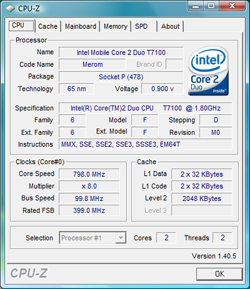 |
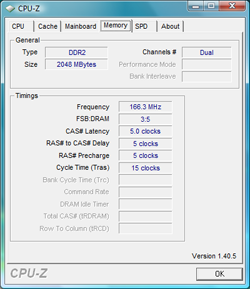 |
At idle, the PC Club ENP660 runs the CPU at 800 MHz using a 400 MHz FSB. The CPU also runs at 0.900V. Memory is run at DDR2-333. Compare this with what the system uses under load:
 |
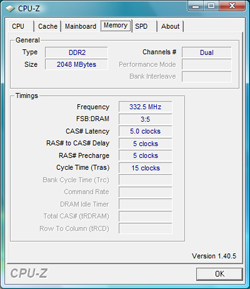 |
Besides the processor jumping up to 1.8GHz and voltage increasing to 1.175V, the FSB and memory speeds double. How much of the difference this makes overall is difficult to say, but maximum performance definitely goes up without seriously impacting battery life.
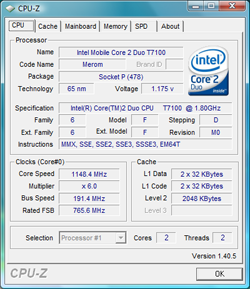 |
 |
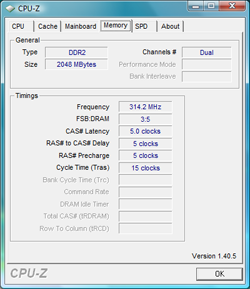 |
 |
One of the interesting side effects of the changing multipliers, memory speeds, front side bus speeds, and ratios is that there's a bit more variance in bus and memory speeds. At idle the system will run in a minimum performance mode, while at load it will run at maximum performance. It's under light to moderate loads that we see unusual numbers. At times we even see the CPU exceed its normal 1.80GHz clock speed, and likewise the memory runs a little faster than DDR2-667. However, this only occurs for short periods of time and the system stability was never compromised by the changing frequencies.
The Santa Rosa platform does allow one CPU core to exceed the rated clock speed by one bin, which can be useful in single-threaded applications. We're not sure that's what we're seeing here, however, as the CPU multiplier never went above 9X. It's the FSB exceeding the rated 333 MHz base speed that's creating this overclock. These "speed bumps" were also short-lived, lasting less than one second and occurring infrequently.










11 Comments
View All Comments
Kayaker123456 - Friday, December 28, 2007 - link
Be careful of buying anything from PC club. I took a computer and brand new case in for work and both cases were damaged. They stripped the alumium screws out on my Lian Li case and screwed in steel ones that stripped the holes. The black piano mirror finish on the Antec Solo case was scratched. Spoke to corporate and was told that they are not responsible. The have a poor rating by the BBB as they do not respond to complaints.Dadoftwo - Wednesday, August 15, 2007 - link
In your opinion, what is the best notebook/laptop money can buy, under $1000? Primary purpose would be for my daughter, a soon-to-be freshman in college majoring in accounting.JarredWalton - Thursday, August 16, 2007 - link
Look at some of the Turion X2 offerings. HP has some that come in at under $1000 with quite a few upgrades. The V6000Z for example - get a 1.8GHz CPU, 2GB RAM, and Office Basic 2007 for right around $1000. Dell's Inspiron 1521 is also pretty decent, and you can get a better LCD (say 1440x900 or 1680x1050) with 2GB and spend right around $1000. Basically, laptops don't tend to give companies a lot of ways to differentiate on the low end. Most $1000 or under laptops will end up being relatively similar - you can add memory and get a smaller HDD, or get a nicer LCD but have less RAM, or some other tradeoff.daytex5 - Wednesday, August 15, 2007 - link
Did the reviewer actually TYPE on the keyboard? After purchasing the the ENP660, I was initially impressed with the board's solid feel, but was quickly frustrated that such a broad case would include a compressed keyboard. Many of the right side keys (Backspace, Enter, period, etc.) are half-size or smaller. Even worse, the right-side Shift key is the size of a standard letter key making it difficult to hit. Whoever made the decision to include the ten-key numeric keypad was not keeping the target audience in mind.
JarredWalton - Thursday, August 16, 2007 - link
I used it quite a bit. It's a personal preference, obviously. The point is, outside of the keyboard there's really nothing else that separates this laptop from other laptops with a similar price and features - except for example the dv6500t is actually $125 cheaper. I like the numeric keypad, and I tend to use the left shift when typing. I was never bothered by the slightly smaller key size or the off-center location of the keys. However, I am sure plenty of people would feel differently.IntelUser2000 - Tuesday, August 14, 2007 - link
It says on Page 13: "At times we even see the CPU exceed its normal 1.80GHz clock speed, and likewise the memory runs a little faster than DDR2-667. However, this only occurs for short periods of time and the system stability was never compromised by the changing frequencies."If you paid attention to the Santa Rosa platform, you'll definitely notice that the increased speed isn't the side effect, but a new feature. Santa Rosa platform has Enhanced Dynamic Acceleration Technology, which allows core speed to go up to one bin when one of the two cores are inactive.
I didn't know it also changed the FSB frequencies though.
JarredWalton - Wednesday, August 15, 2007 - link
The thing is, these are very short changes (like less than .5 seconds), and they occur when the system is only moderately loaded - like playing a WMV9 encoded movie in this case. It could be overclocking for Santa Rosa, but it's not even 1 bin. It's overclocking because the FSB is running at 350 MHz instead of 333 MHz for a brief moment. I realize Santa Rosa allows OC'ing of one bin, but for that I would expect a one bin increase.strikeback03 - Tuesday, August 14, 2007 - link
Have you tested ASTRA32 on any other laptops which definitely have a newer/better panel? Unless HP uses the same OEM as the MSI barebones system, it would seem odd that there is that large a stock of old AU Optronics LCD panels laying around.JarredWalton - Tuesday, August 14, 2007 - link
The most recent LCD manufacturing date that I've seen on a laptop came with the Gateway E-155-C (Jan 2006). However, I wouldn't be surprised if AU Optronics had a bunch of old inventory that they clearanced, which could then be used in laptops to keep prices down.Astra32 reports March 2006 on a Dell 3000WFP and December 2006 on an HP LP3065. It definitely does report more recent dates, then, but is it truly accurate? It might be wrong, but AUO does make a lot of LCDs, and the performance of the MSI/PC Club LCD leaves a lot to be desired. I find it hard to imagine that a more recent LCD would have a black level of nearly 1.0 nits.
AUO also has a list of panels they produce, http://www.auo.com/auoDEV/products.php?sec=noteboo...">found here. The panels used in both the HP and MSI notebooks (and a couple other notebooks) don't show up in that list, though later version are there. At the very least, I thinks it's safe to say that the LCD used is an older model. 30 months old? Maybe not, but then why continue to use a 1280x800 panel on a new laptop if not for price reasons?
madonna grey - Wednesday, October 21, 2020 - link
I have been looking for this information for a long time. By the way, recommend a laptop that will be very convenient for studying.